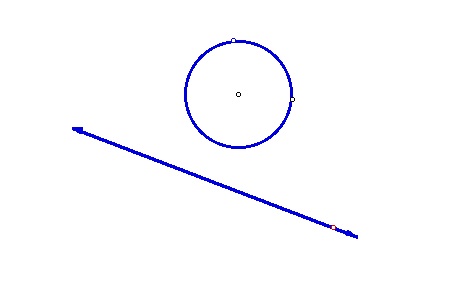

Stephen J. Morgan
EMAT 6680
Assignment #7
Assignment #7 Prompt:
For this write-up I chose to explore the following problem:
"Given a line and a circle with a center K, take an arbitrary point P on the circle. Construct two circles tangent
to the given circle at P and tangent to the line."
From: http://jwilson.coe.uga.edu/emt668/Asmt7/EMT668.Assign7.html

The reason I chose this problem was because I was surprised there would be two circles that would be tangent. Before doing much exploration,
I thought there would only be one and imagine many high school and middle school students would as well.
Assignment 7 Explanation:
As previously stated when I started this investigation I thought that there would only be one circle that would be tangent in the given situation. However, I was able to make a construction using GSP, showing that there are, in
fact two circles. You may click here to see the GSP construction. As I experimented with the GSP file, I observed that when the line through the arbitrary point, P, and the center of the circle was perpindicular to the arbitrary line, the
larger of the two tangent circles appeared to flatten out.
At first I did not understand why this was the case. However, it makes sense when you consider the fact that the point of tangency of the larger circle goes off towards infinity. So, if we could add a point at infinity to our 2-
dimensional picture, we would see this point lying on the larger tangent circle and on the line.
This led me to wonder though, as the second circle becomes a line, we see one circle that is tangent to both the arbitrary line and our flattened out circle. What if instead, however, we took two arbitrary lines? How many circles
would be tangent to both of these lines? What about three lines? Four lines?
Looking at Two Lines:
To begin this question, we will examine what happens when we have two lines. When we have two lines, there are two cases we can explore. In the first case the lines are parallel. In the second case the lines are not. If the lines
are not parallel, then they must intersect at some point. Below are two GPS files. Both of these files show that there are infintely many circles that are tangent to both lines.
Case 2 (Lines Are Not Parallel)
Looking at Three Lines:
When we move from two to three lines, we end up having three cases. In the first case, all three lines are parallel. In the second case, only two of the lines will be parallel. In the third case, none of the lines are parallel. In the first
case, it ends up being impossible for us to find a circle tangent to all three lines. In the second case, there are exactly two circles that end up being tangent to all of the lines. Finally, in the third case there ends up being only one circle
tangent to all three lines. Below are GSP files for cases two and three. I felt that illustrating case one with GSP was not needed since it is fairly easy to see in that case that no tangent circles exist.
Case 2 (Two Lines Are Parallel)
Case 3 ( Lines Are Not Parallel)
Looking at Four Lines:
For cases where we have four lines, we expect there will be a circle that is tangent to all four of the lines. This also means that the center of the circle must be equidistant to all of the lines as well. But the only way this is able to
happen is not if we have a circle. We have to have a square! Click here to see a GSP sketch showing this. It is interesting to note this is the first incidence when the circle tangent to all lines in question is when a regular polygon is formed
at their interesections (not a circle!). In these instances, where we have a regular polygon, we also have an incircle.
If I were to extend this write-up further I would go on to see if we could generalize what would happen for 5 lines, 6 lines, 7 lines, and n-lines, and if a pattern emerges, explain why that is the case.